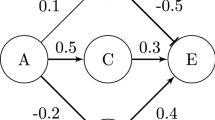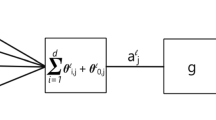Abstract
Neural systems network-based representations are useful tools to analyze numerous phenomena in neuroscience. Probabilistic graphical models (PGMs) give a concise and still rich representation of complex systems from different domains, including neural systems. In this paper we analyze the characteristics of a bidirectional relationship between networks-based representations and PGMs. We show the way in which this relationship can be exploited introducing a number of methods for the solution of classification, inference and optimization problems. To illustrate the applicability of the introduced methods, a number of problems from the field of neuroscience, in which ongoing research is conducted, are used.
Access this chapter
Tax calculation will be finalised at checkout
Purchases are for personal use only
Preview
Unable to display preview. Download preview PDF.
Similar content being viewed by others
References
Abeles, M.: Local Cortical Circuits: An Electrophysiological Study. Springer, Heidelberg (1982)
Amaral, L.A.N., Scala, A., Barthélémy, M., Stanley, H.E.: Classes of small-world networks. Proceedings of the National Academy of Sciences (PNAS) 97(21), 11149–11152 (2000)
Bassett, D.S., Bullmore, E., Verchinski, B.A., Mattay, V.S., Weinberger, D.R., Meyer-Lindenberg, A.: Hierarchical organization of human cortical networks in health and schizophrenia. Journal of Neuroscience 28(37), 9239–9248 (2008)
Brandes, U.: A faster algorithm for betweenness centrality. Journal of Mathematical Sociology 25, 163–177 (2001)
Brown, E.N., Kass, R.E., Mitra, P.P.: Multiple neural spike train data analysis: State-of-the-art and future challenges. Nature Neuroscience 7, 456–461 (2004)
Bullmore, E., Sporns, O.: Complex brain networks: Graph theoretical analysis of structural and functional systems. Nature Reviews: Neuroscience 10, 1–13 (2009)
Clauset, A., Moore, C., Newman, M.E.J.: Hierarchical structure and the prediction of missing links in networks. Nature 453, 98–101 (2008)
Clauset, A., Moore, C., Newman, M.E.J.: Structural Inference of Hierarchies in Networks. In: Statistical Network Analysis: Models, Issues, and New Directions, pp. 1–13. Springer, Heidelberg (2008)
Dorogovtsev, S.N., Goltsev, A.V., Mendes, J.F.F.: Critical phenomena in complex networks. Journal of Modern Physics 80(4), 1275–1335 (2008)
Durstewitz, D., Gabriel, T.: Dynamical basis of irregular spiking in NMDA-driven prefrontal cortex neurons. Cerebral Cortex 17, 894–908 (2007)
Frey, B.J., Dueck, D.: Clustering by passing messages between data points. Science 315, 972–976 (2007)
Guimera, R., Amaral, L.A.N.: Functional cartography of complex metabolic networks. Nature 433, 895–900 (2005)
Izhikevich, E.M.: Polychronization: Computation with spikes. Neural Computation 18(2), 245–282 (2006)
Larrañaga, P., Lozano, J.A. (eds.): Estimation of Distribution Algorithms. A New Tool for Evolutionary Computation. Kluwer Academic Publishers, Dordrecht (2002)
Liben-Nowell, D., Kleinberg, J.: The link-prediction problem for social networks. Journal of American Society for Information Science and Technology 58(7), 1019–1031 (2007)
Lichtman, J.W., Livet, J., Sanes, J.R.: A technicolor approach to the connectome. Nature Reviews: Neuroscience 9, 417–422 (2008)
McIntosh, A.R.: Towards a theory of cognition. Neural Networks 13, 861–870 (2000)
Milo, R., Shen-Orr, S., Itzkovitz, S., Kashtan, N., Chklovskii, D., Alon, U.: Network motifs: Simple building blocks of complex networks. Science 298, 824–827 (2002)
Mühlenbein, H., Paaß, G.: From recombination of genes to the estimation of distributions I. Binary parameters. In: Ebeling, W., Rechenberg, I., Voigt, H.-M., Schwefel, H.-P. (eds.) PPSN 1996. LNCS, vol. 1141, pp. 178–187. Springer, Heidelberg (1996)
Pearl, J.: Probabilistic Reasoning in Intelligent Systems: Networks of Plausible Inference. Morgan Kaufmann, San Mateo (1988)
Rao, R.P.N.: Neural models of Bayesian belief propagation. In: Bayesian Brain. Probabilistic Approaches to Neural Coding, pp. 239–267. MIT Press, Cambridge (2007)
Rolfe, J.T.: The cortex as a graphical model. Master’s thesis, Computation and Neural Systems, California Institute of Technology (2006)
Rykhlevskaia, E., Gratton, G., Fabiani, M.: Combining structural and functional neuroimaging data for studying brain connectivity: A review. Psychophysiology 45, 173–187 (2008)
Sajda, P., Baek, K., Finkel, L.: Bayesian networks for modeling cortical integration. In: Akay, M. (ed.) Handbook of Neural Engineering, pp. 585–600. Wiley Press, Chichester (2007)
Santana, R., Bielza, C., Lozano, J.A., Larrañaga, P.: Mining probabilistic models learned by EDAs in the optimization of multi-objective problems. In: Proceedings of the 11th Annual Genetic and Evolutionary Computation Conference GECCO 2009, pp. 445–452. ACM, New York (2009)
Santana, R., Larrañaga, P., Lozano, J.A.: Interactions and dependencies in estimation of distribution algorithms. In: Proceedings of the 2005 Congress on Evolutionary Computation CEC 2005, Edinburgh, UK, pp. 1418–1425. IEEE Press, Los Alamitos (2005)
Santana, R., Larrañaga, P., Lozano, J.A.: Evolving optimized brain networks topologies using multi-objective evolutionary computation (submmitted for publication 2010)
Santana, R., Mendiburu, A., Lozano, J.A.: An empirical analysis of loopy belief propagation in three topologies: Grids, small-world networks and random graphs. In: Jaeger, M., Nielsen, T.D. (eds.) Proceedings of the Fourth European Workshop on Probabilistic Graphical Models (PGM 2008), pp. 249–256 (2008)
Sporns, O., Kötter, R.: Motifs in brain networks. PLoS Biology 2(11), e369 (2004)
Watts, D.J., Strogatz, S.: Collective dynamics of small-world networks. Nature 393(6684), 440–442 (1998)
Yanover, C., Weiss, Y.: Approximate inference and protein-folding. In: Becker, S., Thrun, S., Obermayer, K. (eds.) Advances in Neural Information Processing Systems, vol. 15, pp. 1457–1464. MIT Press, Cambridge (2003)
Author information
Authors and Affiliations
Editor information
Editors and Affiliations
Rights and permissions
Copyright information
© 2010 Springer-Verlag Berlin Heidelberg
About this paper
Cite this paper
Santana, R., Bielza, C., Larrañaga, P. (2010). Synergies between Network-Based Representation and Probabilistic Graphical Models for Classification, Inference and Optimization Problems in Neuroscience. In: García-Pedrajas, N., Herrera, F., Fyfe, C., Benítez, J.M., Ali, M. (eds) Trends in Applied Intelligent Systems. IEA/AIE 2010. Lecture Notes in Computer Science(), vol 6098. Springer, Berlin, Heidelberg. https://doi.org/10.1007/978-3-642-13033-5_16
Download citation
DOI: https://doi.org/10.1007/978-3-642-13033-5_16
Publisher Name: Springer, Berlin, Heidelberg
Print ISBN: 978-3-642-13032-8
Online ISBN: 978-3-642-13033-5
eBook Packages: Computer ScienceComputer Science (R0)




